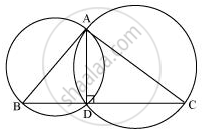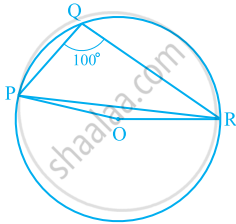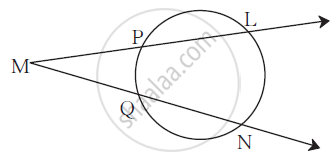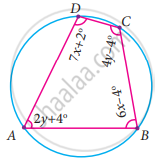Advertisements
Advertisements
Question
If circles are drawn taking two sides of a triangle as diameters, prove that the point of intersection of these circles lie on the third side.
Solution

Consider a ΔABC.
Two circles are drawn while taking AB and AC as the diameter.
Let they intersect each other at D and let D not lie on BC.
Join AD.
∠ADB = 90° ...(Angle subtended by semi-circle)
∠ADC = 90° ...(Angle subtended by semi-circle)
∠BDC = ∠ADB + ∠ADC = 90° + 90° = 180°
Therefore, BDC is a straight line and hence, our assumption was wrong.
Thus, Point D lies on third side BC of ΔABC.
APPEARS IN
RELATED QUESTIONS
A chord of a circle is equal to the radius of the circle. Find the angle subtended by the chord at a point on the minor arc and also at a point on the major arc.
In the given figure, ∠PQR = 100°, where P, Q and R are points on a circle with centre O. Find ∠OPR.

Prove that the circle drawn with any side of a rhombus as diameter passes through the point of intersection of its diagonals.

In the figure m(arc LN) = 110°,
m(arc PQ) = 50° then complete the following activity to find ∠LMN.
∠ LMN = `1/2` [m(arc LN) - _______]
∴ ∠ LMN = `1/2` [_________ - 50°]
∴ ∠ LMN = `1/2` × _________
∴ ∠ LMN = __________
Prove that the centre of the circle circumscribing the cyclic rectangle ABCD is the point of intersection of its diagonals.
ABCD is a cyclic quadrilateral such that ∠ADB = 30° and ∠DCA = 80°, then ∠DAB =
Find all the angles of the given cyclic quadrilateral ABCD in the figure.
In the figure, ▢ABCD is a cyclic quadrilateral. If m(arc ABC) = 230°, then find ∠ABC, ∠CDA, ∠CBE.

If a pair of opposite sides of a cyclic quadrilateral are equal, prove that its diagonals are also equal.
If bisectors of opposite angles of a cyclic quadrilateral ABCD intersect the circle, circumscribing it at the points P and Q, prove that PQ is a diameter of the circle.
